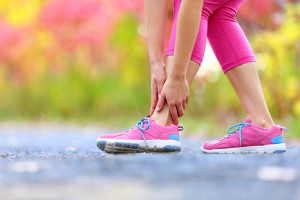Sports Podiatry

We often see sporting injuries to feet, ankles and knees here in the clinic. Our team are here to help with your rehabilitation and peak performance.
High impact sports like football and netball create big stresses on your lower limb joints, muscles ligaments and tendons? That’s why around 70% of sporting injuries involve your lower limbs. Repetitive high impact forces of running and jumping can cause over-use injuries for your heels, shins and knees.
If you’re ready to book an appointment now, call us on 08-9319-3030 or scroll to the bottom of the page to book an appointment online.
Heel Pain
Heel pain is a common overuse injury caused by inflammation when your feet are placed under too much strain. Plantar fasciitis and Achilles tendonitis are two common causes of heel pain.
Plantar fasciitis is caused by inflammation of the plantar fascia, the long strap like tendon under your arch. Heel pain first thing in the morning is a classic symptom of plantar fasciitis with the pain easing once you are up and about.
Your Achilles tendon can become inflamed and painful with over-use. Pain and swelling at the back of your heel and difficulty weight bearing are symptoms of Achilles tendonitis. Achilles tendonitis needs early treatment. Left untreated, chronic inflammation may lead to a tear or rupture that requires surgical repair.
Sever’s disease is another cause of heel pain. Sever’s disease usually occurs in children aged around 11 years who are growing fast. The growth plate at the back of the heel bone is vulnerable to increased mechanical stresses when a growth spurt coincides with increased physical activity. This is often a time when kids are very active and begin to play team sport.
Persistent pain should always be investigated. Early intervention is important as chronic inflammation of your Achilles or plantar fascia are more difficult to relieve and may lead to other painful problems in your knees, hips and back.

Treatment for heel pain
We suggest rest, ice, anti-inflammatory medication, therapeutic ultrasound, stretches, change of footwear and prescription orthotics as just some of the treatments to get your back on the mend.
Our podiatrists are always happy to help you with:
- Assessment, diagnosis and advice
- Stretches and footwear recommendations
- Dry needling and manipulation
- Sports strapping
- Therapeutic ultrasound and soft tissue laser therapy
- Referral for diagnostic ultrasound and x-ray
- Insoles and prescription orthotics
Shin Splints
Shin splints (or Tibial stress syndrome) is one of the most common running injuries. Shin splints are experienced as dull ache or sharp pain along the lower third of your shin bone (tibia) during, or soon after your run.

Shin splints are caused by repetitive strain between your calf muscle and the surface of your tibia. Repetitive strain associated with running causes inflammation and shin pain.
Other factors that may cause or contribute to shin splints are:
- over-striding
- running on hard surfaces
- late stage pronation
- unsuitable running footwear
- being overweight
- weak posterior tibial muscle tendon strength
- your foot type is very flexible and flat or rigid with a high arch
There are a number of other causes of shin pain such as stress fractures or compartment syndrome so it’s important your shin pain is investigated before any treatment commences.
Treatment for shin pain
Because shin splints are caused by inflammation, effective treatment depends on reducing the inflammatory response. So icing your shins is the first thing to do. Reduce the distance and intensity of your run by about 50%. Run on forgiving, soft surfaces like grass whenever possible and reduce your stride length. You can also ease muscle tightness along your shin by massage. Try rolling a ball with some pressure along the soft tissue of your shin. Have your footwear assessed and choose running shoes appropriate for your foot type and training schedule. Also rotate your running shoes each week.
Prescription orthotics designed for running may be required for some runners. Prescription orthotics change the direction of the forces with every stride you take and reduce the strain and inflammation. Prescription orthotics are paired with suitable running shoes to achieve optimal therapeutic effect.
Knee Pain
Runners often complain of knee pain. Pain to the front of the knee, anterior knee pain or patellofemoral joint pain syndrome, can interfere with fitness and training. Pain is felt at the front of the knee, behind the kneecap (patella) and in the tendon which connects the patella to the shin bone (tibia). This type of knee pain is caused by uneven pressure between the kneecap and the thigh bone (femur) forcing the kneecap out of its normal alignment and tracking motion.
Anterior knee pain is easily remedied by:
-
- Change in sports footwear to help correct over-pronantion
-
- Stretches specific for your training and biomechanical problem (calf and hamstring)
-
- Strapping to help hold your patella in position during running
-
- Knee joint bracing for more robust support and control
- Prescription orthotics to correct over pronation
Our podiatrists are always happy to help you maintain your running programme. We know how important it is to keep moving and we’re ready to help you resolve your knee pain right now so you return to your training schedule faster and get back in the game.
We’re here to help you with your lower limb sports injuries and bio-mechanical problems such as shin splints, heel, ankle or knee pain.
Booking an Appointment
Please call 08-9319-3030 or email: [email protected]. Alternatively, you can book an appointment online using the form below.
